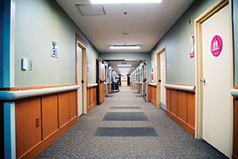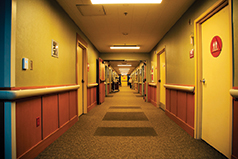In a case of science moving from the lab to the real world, skilled nursing and assisted living operators are discovering the ways in which new lighting technology has resulted in improvements to quality of life for their residents well beyond their expectations.

Called tunable-white LED lighting, the new systems are meant to replace incumbent fluorescent systems. Tunable-white lighting is being promoted as a benefit to providers because it can improve the lighting quality of a facility through increasing light intensity levels, reducing glare, and providing better control when compared with existing systems.
The goal is to allow residents to maintain healthier sleep patterns, improve nighttime safety, and positively affect other behaviors like limiting outbursts with soothing lighting.
Potential is Great
Still in their infancy stage, tunable lights may help to correct circadian rhythm disruption, which is to say how a person’s internal body clock works to regulate the 24-hour-a-day cycle of sleep, being awake, and other daily activities. By correcting these disruptions, an individual can experience more restful sleep, a decreased chance of becoming depressed, and lower levels of aggression (notably for dementia care).
Because of this, lighting is an exciting new area for nursing centers to explore as they implement nonpharmacological approaches to improving dementia care, for example, and deploy energy-saving changes to make their complete infrastructure more efficient.
At night, the body produces large amounts of melatonin, a hormone that induces sleep. When that process is disrupted by so-called blue light (light that does not allow complete sleep, like from a computer screen or other bright source), the body slows production of melatonin, allowing the body to wake up.
“So, in the natural world it is dark at night and so your body pumps out melatonin. Then the sun comes up, you get exposed to daylight, and there is lots of that sort of blue rich light in daylight and that suppresses melatonin,” says Robert Davis, PhD, senior staff lighting engineer, technical director, Solid-State Lighting Program, Pacific Northwest Laboratory in Portland, Ore.
Putting the Principles to Work
But does tunable lighting help prevent these sleeping and waking issues for residents of skilled nursing centers? One provider, ACC Care Center in Sacramento, Calif., has definitely jumped on the pro-tunable lighting bandwagon, according to Administrator Melanie Segar.

“The research has really shown that just like we all take for granted daylight and our sleep patterns, residents don’t typically get the same kind of cues from daylight that we all get as we go about our business,” she says. “It really is different. They don’t have exposure to the light, and it kind of messes with your system. And, we see some of the outcomes from that like not sleeping well at night.”
As ACC became interested in the lighting issue, it partnered with its local utility, the Sacramento Municipal Utility District (SMUD), to conduct a human-centric lighting project. Though there have been some delays in getting the exact technology into place as contractors are still catching up to the advances in lighting, the overall results have been stunning, Segar says.
“We did one private room and one semi-private room, so a very small number, [they also did bathrooms and an office] but we did change the lights in the hall to tunable lights, and we’ve seen a consistent difference on that hallway in terms of falls and a major reduction in behaviors,” she says.
In fact, ACC recorded a 41 percent reduction in agitated behavior in the monitoring period. “And, that seems amazing to me. But we’ve continued to see that there are fewer problems down there [where tunable lights are in place]. So, the phase two project is to put tunable lighting in all of the halls,” Segar says.
Lighting Can be a Balancing Act
As her center sees the benefits of softening the lighting for sleep and brightening during the day, Segar can understand where cost may be a barrier. Grants from SMUD for the project have eased ACC’s financial burden, and the cost is coming down as costs do with the use of new technology over time.
There is also the matter of balancing the lighting needs of the resident with the work being done by staff, which is a unique issue for 24/7-hour facilities like nursing care centers. Instead of having the tunable lights come on and off automatically, the areas where nursing needs are greatest allow for manual control of how bright or dim the lights are, Segar says.
How the Science Works
At the same time providers are working to bring technology to their centers and make advances in quality of care, researchers continue to develop ways to make tunable lighting a reality for more institutions, like in long term care.

“The main reason people are looking at this is due to some new knowledge we have gained over the last 15 years or so about how
the spectrum of light can affect some of the human sleep-wake cycle, and the hormones involved in that,” Davis says. Changes in light can trigger the body to react in different ways, like for example how light in the morning prompts people to wake up, or dimmer light at night reduces stimulation as the body starts the process of moving to its sleep cycle.
“It is all that same underlying theory that has come forth based on the discovery of a new photo receptor in the human retina 15 years ago,” he says. “The upshot of it is that the medical community has documented that the wavelengths of light seem to affect things like melatonin.”
Therein lies the problem in any care center that is open all the time when some people are trying to sleep and others are trying to work.
“There are sort of all those situations and especially in senior care where there is often dementia and other things going on,” Davis says. “If you suppress melatonin in the evening hours or even at night, then you are probably making it harder for people to sleep. And, so exposing people to fairly bright levels of light in the late afternoon or evening is probably going to affect their ability to have a good night’s sleep.”
An Environment of Relaxation
For Davis, the lighting arena is part and parcel of an overall interest in architectural engineering, which at the highest level concerns the view taken from emerging evidence on how the physical environment can increase or decrease stress.
“We are understanding how institutional environments built around the world in the 1970s and 1980s…how the environment itself if it is ugly and has stressful harsh lighting and noise, results in lots of stress on the immune system,” he says.
This stress makes it harder for people to heal and get well, and in long term care it hinders a more relaxing, homey lifestyle that is good for all. “If a provider can make the environment more comfortable and pleasant, that can help,” Davis says. And, tunable light can help and make people feel more relaxed.
“Beyond the color and intensity is the question of how to do we get more light on walls or accent lighting on art work…anything that is more relaxing can make connections to overall well-being.”
Lighting Goes a Long Way
For provider Segar, the ability to make lighting a more natural occurrence for her residents has really moved this technology from a “what if” situation to a “why not” one.
“I mean, we have one resident who has issues of continuously falling, but with this new lighting he has done remarkably well since being in a room with tunable lighting,” she says. “Before we started we knew nothing about it; now I believe it really impacts the quality of life of residents. A good night’s sleep has a direct impact on behavior. This has the potential to be huge.”